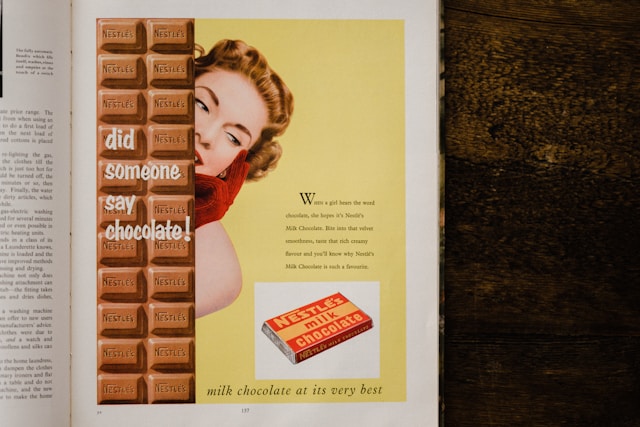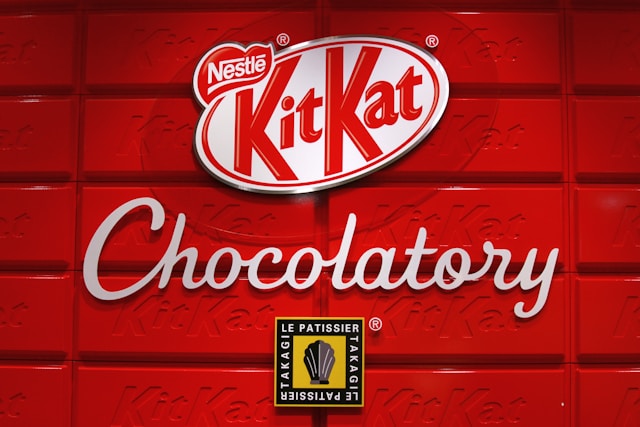Nestlé has built an empire spanning over 150 years. As the world’s largest food and beverage company, Nestlé’s marketing strategy has played a pivotal role in its sustained growth and global dominance. This blog post explores the intricacies of Nestlé’s marketing strategy, highlighting key campaigns that have defined its success. Marketing professionals will find insights and inspiration in Nestlé’s approach to branding, digital transformation, sustainability, and consumer engagement.
Building a Global Brand: The Foundation of Nestlé’s Marketing
Nestlé’s brand strategy is grounded in its commitment to quality and innovation. The company has over 2,000 brands in its portfolio, including household names like Nescafé, KitKat, and Gerber. Nestlé’s ability to adapt its branding to local markets while maintaining a consistent global identity is a cornerstone of its success.
One of the key elements of Nestlé’s branding strategy is its focus on consumer trust. By emphasizing quality and safety, Nestlé has built a reputation that transcends borders. This trust is reinforced through transparent communication and consistent product quality, which are crucial for maintaining consumer loyalty in the highly competitive food and beverage industry.

Digital Transformation: Embracing the Future of Marketing
Nestlé has embraced digital transformation to stay ahead in a rapidly changing market. The company’s digital strategy focuses on leveraging data and technology to enhance consumer engagement and drive growth. This involves a combination of social media marketing, e-commerce, and personalized consumer experiences.
Social Media Engagement
Nestlé uses social media platforms to connect with consumers on a personal level. For instance, the Nescafé brand has been particularly successful on social media, using platforms like Instagram and Facebook to engage with coffee lovers worldwide. Nescafé’s “Good Morning World” campaign, which featured daily coffee moments from around the globe, garnered significant attention and reinforced the brand’s global presence.
E-commerce Integration
With the rise of e-commerce, Nestlé has integrated online sales channels to reach a broader audience. The company has invested in partnerships with major e-commerce platforms and developed its own direct-to-consumer websites. This approach not only boosts sales but also provides valuable data on consumer preferences and buying behaviors.
Personalization and Consumer Insights
Nestlé leverages big data and AI to deliver personalized marketing messages and product recommendations. By analyzing consumer data, the company can tailor its marketing efforts to individual preferences, enhancing the overall consumer experience. This level of personalization is evident in campaigns like the “KitKat Chocolatory,” where consumers can create their own custom KitKat bars online.

Sustainability: A Core Pillar of Nestlé’s Marketing Strategy
Sustainability is at the heart of Nestlé’s marketing strategy. The company recognizes that modern consumers are increasingly concerned about environmental and social issues. By aligning its brand with sustainability, Nestlé not only appeals to conscious consumers but also demonstrates its commitment to corporate responsibility.
Sustainable Sourcing and Production
Nestlé has made significant strides in sustainable sourcing and production. The company’s “Cocoa Plan” aims to improve the livelihoods of cocoa farmers and ensure a sustainable supply chain for its chocolate products. Similarly, the “Nescafé Plan” focuses on sustainable coffee sourcing, improving farm productivity, and reducing environmental impact.
Environmental Initiatives
Nestlé has set ambitious goals for reducing its environmental footprint. The company aims to achieve zero net greenhouse gas emissions by 2050 and has committed to making all its packaging recyclable or reusable by 2025. These initiatives are highlighted in marketing campaigns to showcase Nestlé’s dedication to sustainability and appeal to eco-conscious consumers.
Iconic Marketing Campaigns: Examples of Nestlé’s Success
Nestlé’s marketing campaigns are known for their creativity, emotional appeal, and ability to resonate with diverse audiences. Here are a few examples of iconic campaigns that have contributed to the company’s success.
Nescafé’s “Gold Blend Couple”
In the late 1980s and early 1990s, Nescafé launched the “Gold Blend Couple” campaign in the UK, which became one of the most memorable advertising series of the era. The campaign featured a romantic storyline between two neighbors who bonded over their love for Nescafé Gold Blend coffee. The series of commercials captivated audiences and significantly boosted Nescafé’s brand awareness and sales.
KitKat’s “Have a Break”
KitKat’s “Have a Break, Have a KitKat” slogan is one of the most recognizable in advertising history. The campaign, which started in the 1950s, has evolved over the years but continues to emphasize the brand’s message of taking a break and enjoying a KitKat. The slogan’s longevity and consistency have helped KitKat maintain a strong brand identity and consumer loyalty.
Maggi’s “2-Minute Noodles”
Maggi’s “2-Minute Noodles” campaign revolutionized the instant noodle market. The campaign highlighted the convenience and quick preparation time of Maggi noodles, making them a popular choice for busy families and individuals. The catchy jingle and memorable tagline have made Maggi a staple in households worldwide.
Nespresso’s “What Else?”
Nespresso’s “What Else?” campaign, featuring George Clooney, positioned the brand as a premium coffee experience. The campaign’s sophisticated and humorous approach appealed to coffee connoisseurs and elevated Nespresso’s status in the competitive coffee market. The association with a high-profile celebrity added to the brand’s allure and prestige.
Consumer-Centric Approach: Putting Customers First
Nestlé’s marketing strategy is deeply rooted in a consumer-centric approach. The company invests heavily in understanding consumer needs and preferences, which informs its product development and marketing efforts.
Market Research and Consumer Insights
Nestlé conducts extensive market research to gather insights into consumer behavior and trends. This research helps the company identify new opportunities and tailor its products to meet evolving consumer demands. By staying attuned to consumer preferences, Nestlé can develop products that resonate with its target audience.
Innovation and Product Development
Innovation is a key driver of Nestlé’s success. The company continuously invests in research and development to create new products and improve existing ones. This focus on innovation ensures that Nestlé stays relevant in a competitive market and can meet the diverse needs of consumers.
Customer Feedback and Engagement
Nestlé actively seeks feedback from consumers to improve its products and services. The company uses various channels, including social media, customer surveys, and direct interactions, to gather input from its audience. This feedback loop allows Nestlé to address consumer concerns and enhance the overall customer experience.
Adapting to Local Markets: A Glocal Strategy
One of the hallmarks of Nestlé’s marketing strategy is its ability to adapt to local markets while maintaining a consistent global brand identity. This “glocal” approach enables Nestlé to cater to the unique preferences and cultural nuances of different regions.
Localized Branding and Messaging
Nestlé tailors its branding and messaging to suit local tastes and preferences. For example, in India, the Maggi brand has developed products with flavors that cater to the Indian palate, such as Masala and Chicken noodles. This localization strategy helps Nestlé resonate with local consumers and build a strong market presence.
Cultural Sensitivity and Inclusivity
Nestlé’s marketing campaigns are designed to be culturally sensitive and inclusive. The company ensures that its advertising reflects the diversity of its consumer base and respects local traditions and values. This approach fosters a positive brand image and strengthens consumer trust.
Strategic Partnerships and Collaborations
Nestlé collaborates with local partners to enhance its market reach and credibility. These partnerships can include joint ventures, co-branding initiatives, and sponsorships of local events and programs. By working with local entities, Nestlé can better understand and serve the needs of specific markets.
Future Trends: Nestlé’s Vision for Tomorrow
As Nestlé looks to the future, several trends are likely to shape its marketing strategy. Understanding these trends can provide valuable insights for marketing professionals seeking to emulate Nestlé’s success.
Health and Wellness
The growing emphasis on health and wellness presents opportunities for Nestlé to expand its portfolio of nutritious products. The company is likely to continue investing in healthier options, such as plant-based foods and functional beverages, to meet the demands of health-conscious consumers.
Digital and Technological Advancements
Advancements in digital technology will continue to influence Nestlé’s marketing strategy. The use of artificial intelligence, augmented reality, and other emerging technologies can enhance consumer engagement and provide new avenues for personalized marketing.
Sustainability and Ethical Consumption
Sustainability will remain a key focus for Nestlé. The company is expected to further integrate sustainability into its marketing efforts, highlighting initiatives related to environmental conservation, ethical sourcing, and social responsibility. This focus on sustainability will resonate with increasingly conscious consumers.
Evolving Consumer Preferences
As consumer preferences continue to evolve, Nestlé will need to stay agile and responsive. The company’s ability to anticipate and adapt to changing trends will be crucial for maintaining its market leadership. This includes staying attuned to shifts in dietary habits, lifestyle changes, and cultural trends.
Lessons from Nestlé’s Marketing Strategy
Nestlé’s marketing strategy offers valuable lessons for marketing professionals seeking to build successful brands. Key takeaways include the importance of consumer trust, the power of digital transformation, the significance of sustainability, and the need for a consumer-centric approach. By understanding and applying these principles, marketers can develop strategies that drive growth and foster lasting consumer relationships.
Nestlé’s success is a testament to its ability to innovate, adapt, and connect with consumers on a deep level. By studying Nestlé’s marketing strategy, professionals can gain inspiration and insights that can be applied to their own brands, helping them achieve similar success in an ever-changing market landscape.
Nestlé’s marketing prowess offers numerous insights for marketers aiming to achieve success in their own endeavors. Here are five essential lessons drawn from Nestlé’s strategic playbook:
1. Build and Maintain Consumer Trust
Nestlé’s emphasis on quality and safety has fostered a strong foundation of consumer trust. This trust is not merely established through marketing messages but through consistent delivery on promises. Nestlé ensures that its products meet high standards and communicates transparently with consumers about ingredients, sourcing, and production processes.
- Takeaway for Marketers: Prioritize building trust by maintaining high product standards and transparency. Consistently deliver on promises and communicate openly with consumers to foster long-term loyalty.
2. Leverage Digital Transformation
Nestlé’s strategic embrace of digital transformation has enhanced its consumer engagement and operational efficiency. From social media interactions and personalized marketing to robust e-commerce platforms, Nestlé uses digital tools to stay connected with its audience and adapt to their evolving needs.
- Takeaway for Marketers: Invest in digital technologies to understand and engage your audience better. Utilize social media for direct interaction, employ data analytics for personalized marketing, and optimize e-commerce channels to expand reach and convenience.
3. Align with Sustainability
Nestlé’s commitment to sustainability resonates with the growing segment of eco-conscious consumers. By integrating sustainable practices into its operations and marketing these efforts effectively, Nestlé demonstrates corporate responsibility and attracts like-minded customers.
- Takeaway for Marketers: Integrate sustainability into your brand’s core values and communicate these efforts transparently. Highlight sustainable practices in your marketing campaigns to appeal to environmentally conscious consumers.
4. Adapt to Local Markets
Nestlé’s ability to balance global consistency with local adaptation has been key to its success. The company tailors products and marketing strategies to meet the unique preferences and cultural nuances of each market, ensuring relevance and appeal across diverse regions.
- Takeaway for Marketers: Adopt a “glocal” approach by maintaining a consistent global brand identity while customizing products and marketing messages to suit local markets. Understand and respect cultural differences to create more meaningful connections with local consumers.
5. Innovate Continuously
Innovation drives Nestlé’s ability to stay relevant and meet changing consumer needs. The company invests heavily in research and development to create new products and improve existing ones, ensuring that it remains at the forefront of the industry.
- Takeaway for Marketers: Prioritize innovation to stay competitive. Invest in research and development to explore new product opportunities and enhance existing offerings. Stay attuned to emerging trends and consumer feedback to drive continuous improvement.

